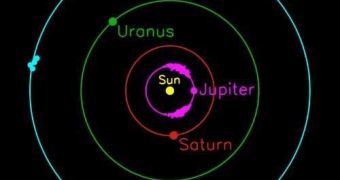Astronomers have just discovered another unusual celestial body in our solar system. It's a small asteroid, only 1 kilometer across that seems to follow Mars during its rotation cycle around the Sun. This is the first object of its kind to show this unusual movement.
Mars has two moons, Phobos and Deimos, which are small and irregularly shaped. Initial theories said it may have been part of the Trojan asteroids, a large group of objects that share the orbit of the planet Jupiter around the Sun. Now, astronomers think it might have been Mars the one that originally insinuated itself into the rock group billions of years ago.
This one, called 2007 NS2, was discovered by astronomers at the La Sagra Observatory in southern Spain on 16 July. Analysis of the light it reflects from the surface indicates that in cosmic terms, it's rather small, with its 1-kilometer radius and that's why it eluded astronomers for so many years.
It is located in a stable orbit called Lagrangian point 5, or L5, which lags the Red Planet by 60? as it moves around the Sun. Two more objects are located in the same point, where the combined gravity of the planet and of the Sun produces a stable orbit. So far, nobody knows how Mars got a hold of the small asteroid and persuaded it to follow it around, since the planet didn't naturally possess it, unlike Jupiter, which has around 2200 of them in its trail, collected about 3.8 billion years ago, when its shifting orbit and gravity propelled many of these objects around the solar system.
The Red Planet may have collected it at a much earlier period, around 4.5 billion years ago, just after the birth of the solar system, explains Trojan researcher Alessandro Morbidelli of the Observatoire de la C?te d'Azur in Nice, France.
Earth possesses no such asteroids, probably because it is too heavy to have been knocked around the same way that Mars was, Morbidelli says. "Mars jumped around because of its small mass, but not the Earth," he says. Mars is just 11% as massive as the Earth.
Further studies are hoped to shed some light on how and why this mysterious object was trapped by Mars and forced to orbit around it as it does the same around the Sun.

 14 DAY TRIAL //
14 DAY TRIAL //